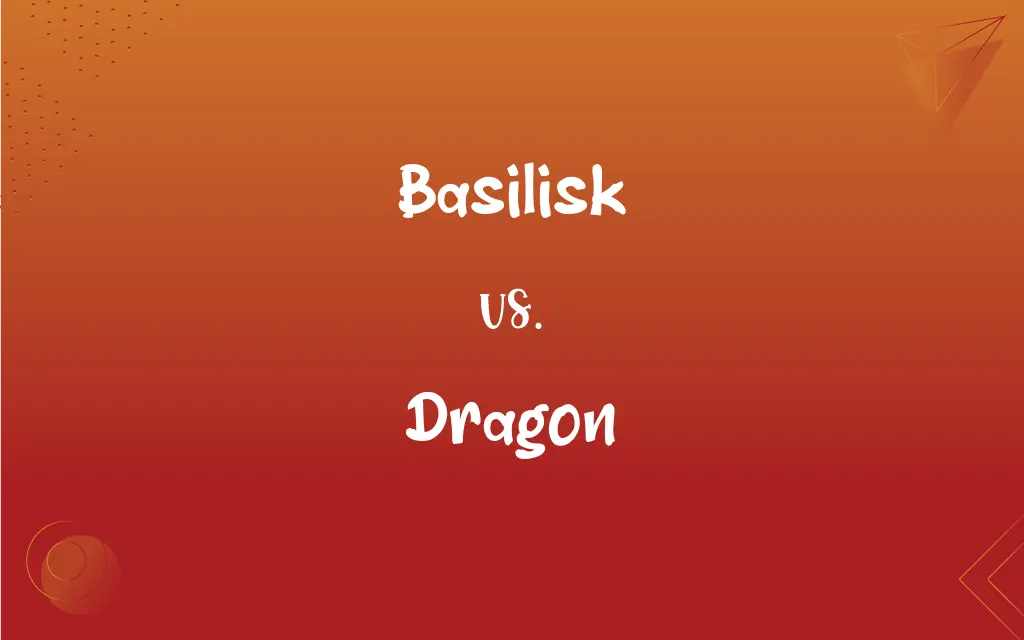Basilisk vs. Dragon: What's the Difference?
By Janet White || Updated on May 20, 2024
A basilisk is a mythical serpent or lizard known for its lethal gaze or breath, while a dragon is a larger, often winged, mythical creature that breathes fire and symbolizes power and majesty.

Key Differences
A basilisk, in mythology, is a serpent or lizard-like creature reputed to kill with a single glance or by its toxic breath. It is often depicted as a small, venomous reptile with the ability to petrify or kill its victims instantly. A dragon, on the other hand, is a large, often winged creature that breathes fire and is a common figure in various mythologies around the world. Dragons are typically depicted as powerful and majestic beings with immense strength.
The basilisk’s origin can be traced back to ancient Greek and Roman legends, where it was described as the king of serpents. Its name comes from the Greek word "basiliskos," meaning "little king." Dragons have a more diverse representation across cultures. In Western mythology, dragons are often seen as malevolent beings that hoard treasure and wreak havoc.
While a basilisk is often portrayed as a solitary and elusive creature, dragons are frequently depicted as either solitary or part of a grand narrative involving knights, heroes, and epic battles. Dragons have a more prominent role in mythological stories, representing both the ultimate challenge for heroes and a source of great wisdom or power.
The physical appearance of a basilisk is usually that of a large snake or a lizard with a crown-like crest on its head. Dragons, however, vary widely in appearance but are commonly shown with massive bodies, scales, wings, and the ability to breathe fire. This difference in size and power underscores their distinct roles in mythology.
Comparison Chart
Definition
Mythical serpent/lizard with lethal gaze
Large, often winged, fire-breathing creature
ADVERTISEMENT
Origin
Ancient Greek and Roman legends
Global mythologies, prominent in Western and Eastern cultures
Symbolism
Fear, danger, death
Power, wisdom, chaos/evil (Western), benevolence (Eastern)
Abilities
Petrifying or killing gaze, venomous bite
Fire-breathing, immense strength, flying
Physical Appearance
Serpent or lizard with crown-like crest
Large body, scales, wings, varying depictions
Basilisk and Dragon Definitions
Basilisk
A creature often depicted with a crown-like crest.
The old manuscript described a basilisk with a regal crest on its head.
ADVERTISEMENT
Dragon
A creature involved in epic battles and stories.
The dragon guarded its hoard of gold in the ancient tale.
Basilisk
A symbol of fear and danger.
The basilisk was feared by all in the medieval village.
Dragon
See Draco2.
Basilisk
A mythical serpent that can kill with its gaze.
Legend says that the basilisk can slay anyone who looks into its eyes.
Dragon
A mythical monster traditionally represented as a gigantic reptile having a long tail, sharp claws, scaly skin, and often wings.
Basilisk
A venomous creature in mythology.
The basilisk's breath is said to be highly toxic.
Dragon
Any of various lizards, such as the Komodo dragon or the flying lizard.
Basilisk
A legendary serpent or dragon with lethal breath and glance.
Dragon
A fiercely vigilant or intractable person.
Basilisk
Any of various tropical American lizards of the genus Basiliscus, having a crest on the head and back and fringes of skin around the toes of the hind feet that enable it to run upright across the surface of water for short distances.
Dragon
Something very formidable or dangerous.
Basilisk
A mythical snake-like dragon, so venomous that even its gaze was deadly.
The deadly look of the basilisk
Dragon
(Archaic) A large snake or serpent.
Basilisk
(science fiction) An infohazard or cognitohazard, especially a Langford's basilisk.
Dragon
A legendary serpentine or reptilian creature.
Basilisk
(heraldry) A type of dragon used in heraldry.
Dragon
In Western mythology, a gigantic beast, typically reptilian with leathery bat-like wings, lion-like claws, scaly skin and a serpent-like body, often a monster with fiery breath.
Basilisk
A tree-dwelling type of lizard of the genus Basiliscus: the basilisk lizard.
Dragon
In Eastern mythology, a large, snake-like monster with the eyes of a hare, the horns of a stag and the claws of a tiger, usually beneficent.
Basilisk
A type of large brass cannon.
Dragon
An animal of various species that resemble a dragon in appearance:
Basilisk
Suggesting a basilisk (snake-like dragon): baleful, spellbinding.
Dragon
(obsolete) A very large snake; a python.
Basilisk
A fabulous serpent, or dragon. The ancients alleged that its hissing would drive away all other serpents, and that its breath, and even its look, was fatal. See Cockatrice.
Make me not sighted like the basilisk.
Dragon
Any of various agamid lizards of the genera Draco, Physignathus or Pogona.
Basilisk
A lizard of the genus Basiliscus, belonging to the family Iguanidæ.
Dragon
A Komodo dragon.
Basilisk
A large piece of ordnance, so called from its supposed resemblance to the serpent of that name, or from its size.
Dragon
The constellation Draco.
Basilisk
(classical mythology) a serpent (or lizard or dragon) able to kill with its breath or glance
Dragon
(pejorative) A fierce and unpleasant woman; a harridan.
She’s a bit of a dragon.
Basilisk
Ancient brass cannon
Dragon
The (historical) Chinese empire or the People's Republic of China.
Napoleon already warned of the awakening of the Dragon.
Basilisk
Small crested arboreal lizard able to run on its hind legs; of tropical America
Dragon
(figuratively) Something very formidable or dangerous.
Basilisk
A mythical reptile with petrifying abilities.
Stories tell of a basilisk turning men to stone with a glance.
Dragon
A type of playing-tile (red dragon, green dragon, white dragon) in the game of mahjong.
Dragon
A luminous exhalation from marshy ground, seeming to move through the air like a winged serpent.
Dragon
A short musket hooked to a swivel attached to a soldier's belt; so called from a representation of a dragon's head at the muzzle.
Dragon
A background process similar to a daemon.
Dragon
A variety of carrier pigeon.
Dragon
(slang) A transvestite man, or more broadly a male-to-female transgender person.
Dragon
A fabulous animal, generally represented as a monstrous winged serpent or lizard, with a crested head and enormous claws, and regarded as very powerful and ferocious.
The dragons which appear in early paintings and sculptures are invariably representations of a winged crocodile.
Thou breakest the heads of the dragons in the waters.
Thou shalt tread upon the lion and adder; the young lion and the dragon shalt thou trample under feet.
He laid hold on the dragon, that old serpent, which is the Devil and Satan, and bound him a thousand years.
Dragon
A fierce, violent person, esp. a woman.
Dragon
A constellation of the northern hemisphere figured as a dragon; Draco.
Dragon
A luminous exhalation from marshy grounds, seeming to move through the air as a winged serpent.
Dragon
A short musket hooked to a swivel attached to a soldier's belt; - so called from a representation of a dragon's head at the muzzle.
Dragon
A small arboreal lizard of the genus Draco, of several species, found in the East Indies and Southern Asia. Five or six of the hind ribs, on each side, are prolonged and covered with weblike skin, forming a sort of wing. These prolongations aid them in making long leaps from tree to tree. Called also flying lizard.
Dragon
A variety of carrier pigeon.
Dragon
A fabulous winged creature, sometimes borne as a charge in a coat of arms.
Dragon
A creature of Teutonic mythology; usually represented as breathing fire and having a reptilian body and sometimes wings
Dragon
A fiercely vigilant and unpleasant woman
Dragon
A faint constellation twisting around the north celestial pole and lying between Ursa Major and Cepheus
Dragon
Any of several small tropical Asian lizards capable of gliding by spreading winglike membranes on each side of the body
Dragon
A large, mythical creature that breathes fire.
The dragon's fiery breath scorched the landscape.
Dragon
A powerful and majestic being in mythology.
Knights often sought to slay dragons to prove their bravery.
Dragon
Often depicted with wings and scales.
The dragon spread its wings and took to the sky.
Dragon
A symbol of power and wisdom.
In Chinese culture, the dragon is revered as a symbol of strength and good fortune.
FAQs
What is a dragon?
A dragon is a large, often winged, mythical creature that breathes fire and symbolizes power and majesty.
What abilities does a basilisk have?
A basilisk can kill with its gaze and has a venomous bite.
Where do dragons appear in mythology?
Dragons appear in global mythologies, prominently in Western and Eastern cultures.
What is a basilisk?
A basilisk is a mythical serpent or lizard known for its lethal gaze or toxic breath.
What abilities does a dragon have?
Dragons can breathe fire, possess immense strength, and often have the ability to fly.
Where does the basilisk originate from?
The basilisk originates from ancient Greek and Roman legends.
What is the symbolism of a dragon?
Dragons symbolize power, wisdom, and can represent chaos or evil in Western cultures and benevolence in Eastern cultures.
How is a dragon depicted physically?
Dragons are depicted with large bodies, scales, wings, and the ability to breathe fire.
How is a basilisk depicted physically?
A basilisk is often depicted as a serpent or lizard with a crown-like crest.
Are dragons solitary or social in myths?
Dragons can be depicted as solitary or as part of grand narratives involving heroes and battles.
What cultural significance do dragons hold?
Dragons hold significant cultural importance, representing power and wisdom in many cultures, especially in Chinese mythology.
What is the symbolism of a basilisk?
A basilisk symbolizes fear, danger, and death.
Are basilisks solitary creatures in myths?
Yes, basilisks are often portrayed as solitary and elusive creatures.
Do basilisks appear in modern fiction?
Yes, basilisks appear in modern fiction, often as dangerous mythical creatures.
What is a famous story involving a basilisk?
The story of the basilisk in the medieval bestiary "Physiologus" is one of the most famous tales.
Can a basilisk be defeated in mythology?
In mythology, basilisks are sometimes defeated by heroes using mirrors or reflective surfaces to turn their lethal gaze back on them.
What cultural significance does the basilisk hold?
The basilisk holds cultural significance as a symbol of deadly danger in ancient folklore.
Do dragons appear in modern fiction?
Yes, dragons are popular in modern fiction, often featured in fantasy literature and films.
How are dragons typically defeated in myths?
Dragons are often defeated by brave heroes or knights, usually through combat or clever tactics.
What is a famous story involving a dragon?
The legend of St. George and the Dragon is a well-known story involving a dragon.
About Author
Written by
Janet WhiteJanet White has been an esteemed writer and blogger for Difference Wiki. Holding a Master's degree in Science and Medical Journalism from the prestigious Boston University, she has consistently demonstrated her expertise and passion for her field. When she's not immersed in her work, Janet relishes her time exercising, delving into a good book, and cherishing moments with friends and family.
































































